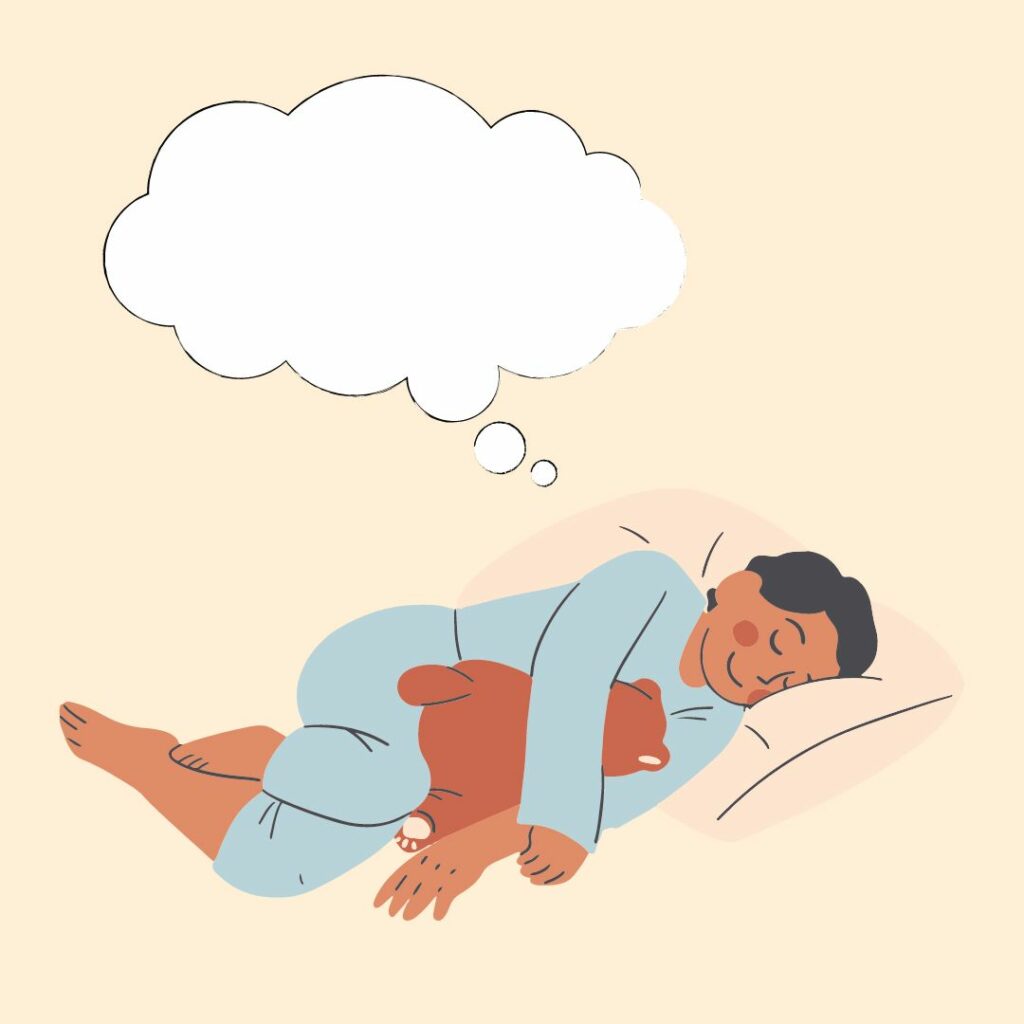Exploring Insomnia

Earlier this year, we shared a blog post entitled What to do When You Can’t Sleep. This post explored approaches to coping with the sleep deprivation that comes with pruritus—whether the itch is yours or your child’s. If pruritus is not a significant barrier to sleep for you right now, that’s wonderful!
Pause and take a deep breath on behalf of the patients and families for whom the itch is an all-day, all-night struggle. Imagine that with your in-breath, you can take in some small portion of their pain, and with your out-breath, you can send calm or courage or compassion their way. If, on the other hand, you find yourself in this itchy, sleep-starved struggle right now, take a deep breath, too. Allow yourself to feel the air that others are moving on your behalf. Feel into your connection with the broader PFIC community. You are not alone.
Does this all seem a bit woo woo? Here’s the thing: this exercise doesn’t have to literally work—doesn’t have to literally deliver calm or courage from one person to another—for it to be effective. When you allow yourself to feel into the experience of breathing for someone else and sending good wishes their way, you feel your way out of isolation. The same thing can happen if you imagine another person breathing for you, sending good wishes to you.
This isn’t a game of make believe. It’s a way to step out of the fiction of isolation and into the reality that we are all connected. In every moment and every situation, there is someone else going through challenges like yours. You are not alone. This can be hard to remember in the middle of the night, though! The rest of this post is intended for patients and caregivers who struggle with insomnia even though pruritus is not keeping them awake.

Here is an experience that is familiar to most people. You’re exhausted after a long day and too many nights of inadequate sleep. You collapse into bed . . . but you don’t fall asleep. You might try a few really excellent tools, like deep breathing or progressive muscle relaxation. And still, you don’t sleep, or if you do, you snap awake much too soon. Perhaps you begin thinking about medical treatments or health insurance or all the things that could go wrong or are going wrong for you or your child. At some point, you might also start thinking along these lines: “What’s wrong with me! Why can’t I sleep? If I don’t fall asleep right away, tomorrow is going to be awful! I need to stop worrying and sleep right now!”
These thoughts are not calming. Odds are, they don’t lull you to sleep. Instead, you begin feeling more agitated, anxious, and awake. This makes your other worries feel bigger and heavier, too, which in turn may make you feel more desperate for sleep. You are caught in a spiral that doesn’t lead where you want to go.
If you google “how to sleep,” you’ll find that the Internet is rife with tips and suggestions, many of which can be quite helpful. You can read some examples here. But if you are stuck in perpetual thought spirals about your insomnia, then reducing your exposure to blue light or drinking a cup of chamomile tea are not likely to catalyze dramatic improvements. We need to exit the spiral before these other tricks and tips can yield their full benefits.
A few years ago, I was dealing with significant medical issues that caused insomnia. After many months of illness, most of my symptoms began to improve, but the insomnia did not. After a few hours of lying awake in bed, I’d find myself in a state of mental warfare with my own sleeplessness. At the peak of my sleep deprivation, I became so frustrated with this that I decided I wouldn’t even try to sleep anymore. Instead, I hatched the idea to begin writing a book of bedtime stories for adult insomniacs—stories that could offer comfort in the wee hours of a miserable and sleepless night.All of my writing, I decided, would take place during my own sleepless nights. I was so excited to get started! This idea came to me around dawn, so I just needed to get through that day and then, I’d go to bed, give myself half an hour to try (and fail) to fall asleep, then pop up to begin writing. I went to bed that night brimming with enthusiasm. I was so excited to not sleep. Something bizarre and unexpected happened, though. I fell asleep quickly and easily for the first time in over a month, then slept soundly through the night. I was perplexed but undeterred. The next night, I was sure, I’d pick back up where I left off with my insomnia, and I would begin writing my book. But again, I fell asleep easily. My pattern of sleeplessness was broken and has not returned. Someone else will have to write that book!

I’m not sharing this story to suggest that you need to take on this book project. I’m sharing because it highlights something important about how our mindset impacts our sleep. Until I came up with my book idea, I was chasing sleep every night. I was desperate to catch it, and sleep itself was this elusive thing that always seemed beyond my grasp. The thing is, chasing anything is inherently strenuous. It’s work and struggle, not rest or relaxation. Sleep is like a skittish animal. If you chase it, it tends to run away.
So how do you stop chasing sleep, even when you’re exhausted and sleep deprived? There is no one-size-fits-all answer here. Below is a short list of suggestions that you may want to play around with. The word play here is important. If you can bring a touch of curiosity and playfulness to your experience of insomnia, then three things are likely to happen: 1) you’ll feel less stressed out about your lack of sleep, 2) you’ll be more likely to come up with your own creative approaches and solutions, and 3) with your stress reduced and your own tailored-to-you approaches to sleep in place, you’ll be more likely to catch enough z’s.
- Name your night owl. Give a name—ideally, a silly one—to the wide-awake, stress-spiraling part of you. When you find yourself lying awake, stuck in an unhelpful thought loop, greet that part of yourself by name. “Hi, Brunhilda. Fancy meeting you here!” This brings levity to a tough moment and also serves as a reminder that you are not your thoughts, your fears, your stress, or your insomnia. To create even more space between you and your doom-and-gloom thoughts, try out this 10-minute Leaves on a Stream Meditation.


- Try on a new thought. Replace a thought that’s causing you stress (and sleeplessness!) with a thought that’s just as true or truer but feels soothing. For example, if you find yourself repeatedly thinking, “I need to sleep,” you might try replacing it with the mantra “I need rest, and I am resting.” If you find yourself asking “What’s wrong with me?” you might repeat “Lots of people are lying awake right now, just like me.” Maybe you can even take a few deep breaths on their behalf. If you’re awake because you’re worrying about what will happen with your health or your child’s health a day or a month or a year down the line, try on the phrase: “Right now, we are okay.”
- Treat yourself. Take some of the dread out of the experience of insomnia by giving yourself some small thing to enjoy on sleepless nights. You might decide, for example, that after lying awake for a certain amount of time, you will treat yourself to a favorite book, a guided Yoga Nidra or progressive relaxation practice, or a mug of your favorite herbal tea. This could also be a good time for doodling, coloring, writing in a gratitude journal or taking up a meditation practice. Choose something that’s calming and feels good to you, then enjoy a short stretch of it before climbing back in bed.


- Be a scientist. Make a list of ways that you might be able to improve your sleep or sense of restfulness, then try them out, one at a time. If you like making charts, keep track of your results, and see if you can pick up on any patterns or trends that surprise you. The key is to approach this with curiosity rather than desperation for a particular result. Remember, if you chase sleep, it tends to run!
When confronted with a problem, it’s normal to ruminate, worry, or try to control things. It’s normal to get swept into a mental and emotional spiral. Our best and most creative approaches to problems tend to occur when we step out of that spiral, though. Insomnia is no different. Breaking unhelpful thought patterns might seem hard or even impossible. It’s okay to need support! We encourage you to reach out to a therapist or attend one of our support groups. As you’re finding your way forward, keep in mind that play and curiosity will generally take you farther than amped up attempts at control; plus, they feel better.
We wish you moments of play, curiosity, and creativity, as well as an increase in rest . . . and who knows, maybe also in sleep!
